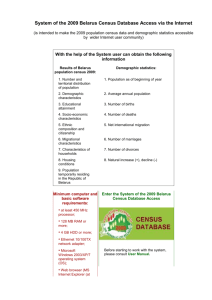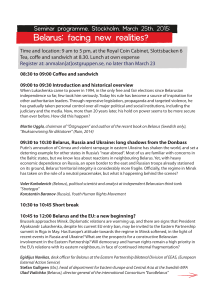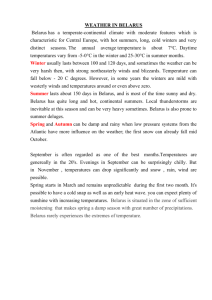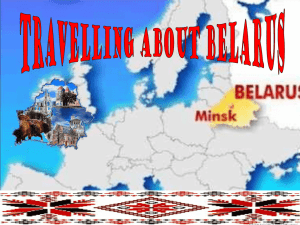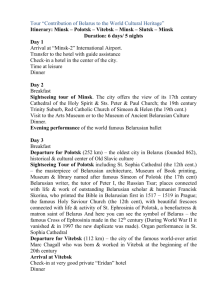Unit 7: Country Area Studies--Belarus Objectives Be aware of the following
advertisement
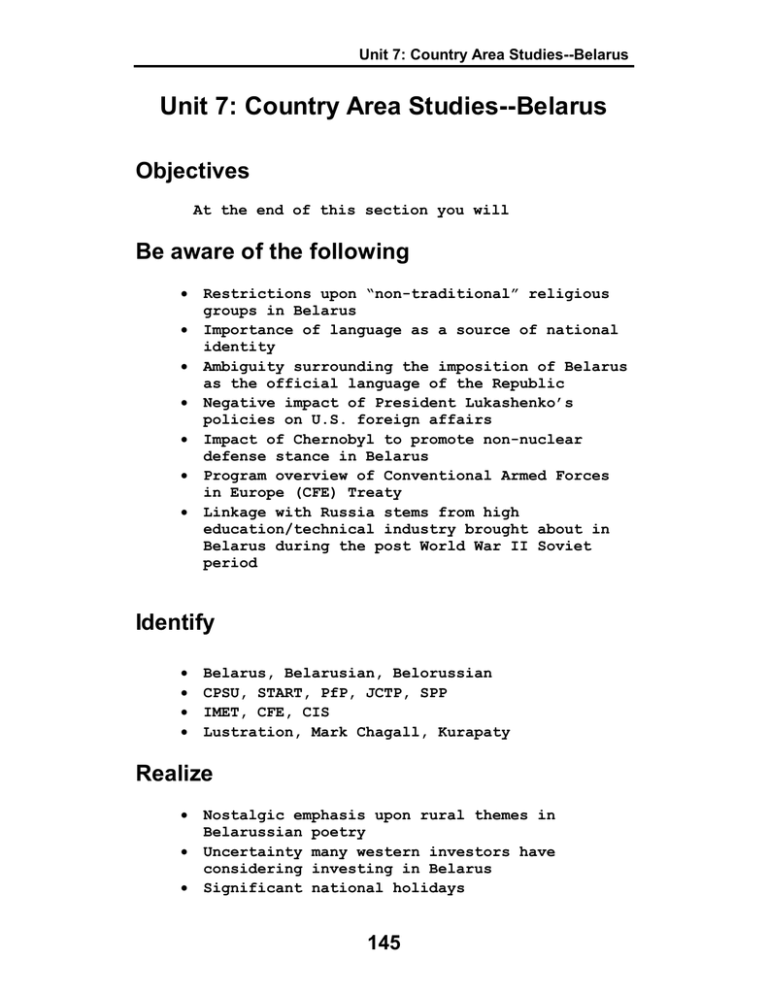
Unit 7: Country Area Studies--Belarus Unit 7: Country Area Studies--Belarus Objectives At the end of this section you will Be aware of the following • Restrictions upon “non-traditional” religious groups in Belarus • Importance of language as a source of national identity • Ambiguity surrounding the imposition of Belarus as the official language of the Republic • Negative impact of President Lukashenko’s policies on U.S. foreign affairs • Impact of Chernobyl to promote non-nuclear defense stance in Belarus • Program overview of Conventional Armed Forces in Europe (CFE) Treaty • Linkage with Russia stems from high education/technical industry brought about in Belarus during the post World War II Soviet period Identify • • • • Belarus, Belarusian, Belorussian CPSU, START, PfP, JCTP, SPP IMET, CFE, CIS Lustration, Mark Chagall, Kurapaty Realize • Nostalgic emphasis upon rural themes in Belarussian poetry • Uncertainty many western investors have considering investing in Belarus • Significant national holidays 145 Unit 7: Country Area Studies--Belarus • Historic Belarusian tradition of calmness, tolerance, and neutrality • Similarities between Ukraine/Belarussian manners and customs • Gestures and taboos of Belarusian society 146 Unit 7: Country Area Studies--Belarus Belarus (byay-lah-ROOS, be-lah-ROOS) Republic of Belarus, Belarusian “It was only after the Supreme Soviet declared the country independent that the name was changed from the Belorussian Soviet Socialist Republic to the Republic of Belarus...(Country Study)” Population % under 15 years Communication TV Radio Phone Newspaper Health Life Expectancy Hospitals Doctors IMR Income Literacy 10,415,973 21% 1/4.4 1/3.5 1/5.3 187/1000 63.2/74.21 1/82 1/230 13.4/1000 $4,700.00 98% 147 Unit 7: Country Area Studies--Belarus I. Religious Groups 1. Identity a. Eastern Orthodox 60% b. Other 40% (Includes Roman Catholic, Apostolic Christian, Baptist, Muslim, New Apostolic, Old Believer, Pentecostal, Seventh-Day Adventist, Uniate, Jewish, Atheist plus smaller groups) 2. Freedom of Religion “The Constitution provides for freedom of religion, however, the Government restricts this right in practice. A 1995 Cabinet of Ministers decree controlling religious workers as a means of attempting to protect Orthodoxy and prevent the growth of evangelizing religions is enforced... Citizens are not prohibited from proselytizing, but foreign missionaries may not engage in religious activities outside the institutions that invited them. Only religious organizations already registered in Belarus may invite foreign clergy. The Government and the President encourage a greater role for the Orthodox Church, largely as part of an overall strategy to strengthen Slavic unity in the region. The effort, however, has not slowed the growth of Roman Catholic and Protestant churches. 148 Unit 7: Country Area Studies--Belarus Bishops must receive permission from the State Committee on Religious Affairs before transferring a foreign priest to another parish. Restitution of religious property remained limited in 1997. A key obstacle is the lack of a legal basis for restitution of property that was seized during the Soviet era and the Nazi occupation. The few returns of property to religious communities have been on an individual and inconsistent basis. Over the past several years, the Jewish community has successfully lobbied the Government to return three synagogues in Minsk and several buildings outside the capital. Following extensive renovations, the Catholic community in October rededicated a cathedral in Minsk that had been returned in recent years. In an address to the Parliament, the Orthodox Patriarch urged the Government to move quickly to return religious property” (Unless otherwise stated, the following quotes come from the Belarus Country Report on Human Rights Practices for 1997). II. Ethnic/Racial Groups 1. Identity a. Belarusian 77.9% b. Russian 13.2% c. Polish 4.1% 149 Unit 7: Country Area Studies--Belarus d. Ukrainian 2.9% e. Other 1.9% 2. Equal Rights a. Constitutional mandate “The Constitution states that all citizens are equal before the law and have a right, without any discrimination, to equal protection of their rights and legitimate interests, but it does not specifically prohibit discrimination based on factors such as race, sex, or religion. The Law on Citizenship, passed by the Parliament, grants citizenship to any person living permanently on the territory of Belarus as of October 19, 1991. Those who arrived in Belarus after that date and wish to become citizens are required to submit an application for citizenship, take an oath to support the Constitution, have a legal source of income, and have lived in the country for 7 years. The 1995 Law on Immigration and Migration provided numerical limits on new citizens but the Parliament again failed to budget funds for its implementation” (Belarus Country Report on Human Rights Practices for 1997). b. Anti-Semitism “Societal anti-Semitism exists, but it is not usually manifested openly. Senior Government officials, including the President, and the State media used coded anti-Semitism in their attacks on perceived opponents...” According to Yale Richmond, Jewish peoples were one-fourth of Belarus’ pre World War II population, and half of urban dwellers. Within the old Russian Empire, Belarus was one of the safest places for Jewish peoples and other minorities. (See From Da to Yes, p. 259). c. Illegal immigration Border guards, located along the Polish/Ukraine border, stop illegal immigration into Poland. In addition, these security units halt the flow of narcotics, stolen cars and 150 Unit 7: Country Area Studies--Belarus contraband materials (cigarettes, alcohol, fuel and weapons). 3. Language “Comparing people’s speech to the ‘vestment of the soul,’ the poet Francisak Bahusevic (1840-1900) exhorted his countrymen: ‘Do not abandon our Belarusian language lest you die!’” “‘Language is not only a means of communication, but also the soul of a nation, the foundation and the most important part of its culture.’ So begins the January 1990 Law About Languages in the Belorussian SSR, which made Belarusian the sole official language of the republic.” a. Overview “The Belarusian language is an East Slavic tongue closely related to Russian and Ukrainian, with many loan-words from Polish (a West Slavic language) and more recently from Russian. The standard literary language, first codified in 1918, is based on the dialect spoken in the central part of the country and is written in the Cyrillic alphabet. Under Polish influence, a parallel Latin alphabet (lacinka) was used by some writers in the eighteenth and nineteenth centuries and is still used today by some Roman Catholics in Belarus and abroad.” b. Importance “One early proponent of the Belorussian language, poet Francisak Bahusevic (1840-1900), the father of modern Belorussian literature and a participant in the 1863 uprising, was inspired by the fact that many 200- and 300-year-old documents written in Belorussian could be read and understood easily in modern times. 151 Unit 7: Country Area Studies--Belarus The theme of the native language as a repository of national identity and an expression of aspiration to nationhood has been the leitmotif of Belorussian literature and polemics beginning in the late nineteenth century.” c. History, 1897-1920s (1) Popular use “Although the tsarist government regarded the Belorussians as well as the Ukrainians as another branch of Russians, not as a separate nation, the Belorussian language was registered in the first systematic census of the Russian Empire in 1897. In the early 1920s, Belorussian language and culture flourished, and the language was promoted as the official medium of the Communist Party and the government as well as of scholarly, scientific, and educational establishments. Most primary and secondary schools switched to instruction in Belorussian, and institutions of higher education gradually made the switch as well. The Belorussian State University was founded in 1921, the Institute of Belorussian Culture was founded in 1922, and a number of other institutions of higher learning also opened. The interests of other minorities in the republic were taken into account in a July 1924 decree that confirmed equal rights for the four principal languages of the republic: Belorussian, Polish, Russian, and Yiddish.” (2) Literary figures “The development of Belorussian literature, spreading the idea of nationhood for the Belorussians, was epitomized by the literary works of Yanka Kupala (1882-1942) and Yakub Kolas (1882-1956). 152 Unit 7: Country Area Studies--Belarus The works of these poets, along with several other outstanding writers, became the classics of modern Belorussian literature by writing widely on rural themes (the countryside was where the writers heard the Belorussian language) and by modernizing the Belorussian literary language, which had been little used since the sixteenth century. Postindependence authors in the 1990s continued to use rural themes widely.” d. Resurgence following perestroika “With the advent of perestroika, national activists launched a campaign of restoring the Belorussian language to the place it had enjoyed during the 1920s. To urge the government to make Belorussian the official language of the republic, the Belarusian Language Society was established in June 1989 with poet-scholar Nil Hilyevich as president. Belorussia's Communist Party of the Soviet Union (CPSU) leadership, consisting almost exclusively of Russified technocrats, ignored all the government resolutions and decisions on languages. However, it could not ignore the general language trend throughout the non-Russian republics of the Soviet Union, particularly in the neighboring Baltic states and Ukraine, where national movements were stronger and exerted an influence on events in the Belorussian SSR. After months of meetings, rallies, conferences, and heated debates in the press, on January 26, 1990, the Supreme Soviet voted to make Belarusian the official language of the state, effective September 1, 1990. The law included provisions for protecting the languages of minorities and allowed up to ten years to make the transition from Russian to Belarusian.” e. Current ambiguities “Despite the provisions, implementation of the law has encountered both active and passive resistance: many people still want their children to be educated in the Russian language rather than in Belarusian, and some government officials agree to give interviews only in Russian. 153 Unit 7: Country Area Studies--Belarus According to data assembled in 1992 by the Sociology Center of the Belarusian State University, some 60 percent of those polled prefer to use Russian in their daily life, 75 percent favor bilingualism in state institutions, and only 17 percent favor having the government declare Belarusian the sole official language. One Western source reported that in the early 1990s, only 11 percent of the population, most of whom lived in the countryside, were fluent in Belarusian. Since late 1992, there had been a growing demand that the Russian language be given the same official status as Belarusian. The results of the four-question referendum of May 1995, which included a question on whether Russian should be an official language, put an end to any uncertainty; the populace voted ‘yes.’” Thus both Russian and the Belarusian language are the “official” languages of Belarus. f. Dialects Two main dialects characterize the Belarusian language: the Northeastern (Polotsk and Vietbsk-Mogilev) and Southwestern (Grodno-Baranovichi and Slutsk-Mozir). III. Gender Issues 1. Women a. Abuse “Although statistics are not available, domestic violence including spousal abuse against women is a significant problem, according to women's groups. There are laws against spousal abuse. Knowledgeable sources indicate that police generally are not hesitant to enforce the laws against domestic violence and that the courts are not reluctant to impose sentences. 154 Unit 7: Country Area Studies--Belarus The main problem, according to women's groups, is a general reluctance among women to report incidents of domestic violence.” b. Wages “The law requires equal wages for equal work; however, such is not always the case in practice. Women have significantly less opportunity for advancement to the upper ranks of management. Women report that managers frequently take into consideration whether a woman has children when considering potential job opportunities.” c. Education “The level of education of women is higher than that of men. Women make up 58 percent of workers with a higher education and 66 percent of workers with a specialized secondary education. Despite the higher level of education, women are employed in lower paying fields, such as health care and education. In these sectors, between two-thirds and three-fourths of the employees (mostly women) are living beneath the official poverty level. Women are equal to men before the law with regard to property ownership and inheritance. There are active women's groups, most of them focusing on issues such as child welfare, environmental concerns (in the aftermath of Chernobyl), and preserving the family. A private university in Minsk established the country's first gender-studies faculty this year.” 2. Children “The Government is committed to children's welfare and health, particularly as related to the consequences of the nuclear accident at Chernobyl, and, with the help of foreign donors, gives them special attention. By law everyone is entitled to health care, including children. Children begin school at the age of 6 and are required to complete 9 years, although the Government makes 11 years of education available at no cost. Higher education is also available at no cost on a competitive basis. Families with children receive token Government benefits. A World Bank study found 155 Unit 7: Country Area Studies--Belarus that the majority of those living in poverty are families with multiple children or single mothers. There does not appear to be a societal pattern of abuse of children.” 3. People with Disabilities “A 1992 law mandated accessibility to transport, residences, businesses, and offices for the disabled; however, facilities, including transport and office buildings, often are not accessible to them. The Government, facing a deteriorating economic situation, failed to budget sufficient funds to implement these laws. However, when the Government slashed subsidies for most sectors of society, most subsidies for the disabled remained in force.” IV. Conflicts “International disputes: none” (The World Factbook Page on Belarus, Central Intelligence Agency, 1997). V. U.S. Policy 1. U.S. Foreign Policy Objectives a. Specifics “The United States seeks an independent, democratic Belarus which respects human rights, possesses a market economy, pursues sustainable economic development, contributes to regional peace and stability, and plays a constructive role in the international community. Belarus’ status as a nuclear-free state must be preserved. The U.S. also seeks full compliance by Belarus with the Treaty on Conventional Forces in Europe. Even in its current highly selective 156 Unit 7: Country Area Studies--Belarus framework, U.S. engagement with Belarus is directed toward encouraging and supporting Belarus’ economic and social interests which, despite official harassment, remain committed to democratic pluralism and economic reform” (Unless otherwise stated, the following quotes come from Congressional Presentation for Foreign Operations, FY 1999). b. President Lukashenko “Belarus President Lukashenko, who orchestrated a flawed and undemocratic constitutional referendum in 1996, increasingly has challenged the principles of separation of powers; freedom of assembly, expression, and due process; and has failed to maintain Belarus’ international commitments. In response, the United States has limited bilateral diplomatic contacts, curtailed direct assistance to the state sector including substantial Cooperative Threat Reduction (Nunn-Lugar) funding and United States Information Services (USIS) exchanges with leading legislators and judicial officials, and discouraged new U.S. investment in Belarus.” 2. Defense and Military Issues a. START “In Lisbon on May 23, 1992, the United States signed a protocol to the Strategic Arms Reduction Treaty (START) with Belarus, Russia, Kazakstan, and Ukraine (those states on whose territory strategic nuclear weapons of the former Soviet Union are located). The protocol makes the four states party to the START Treaty and commits them to reductions in strategic nuclear weapons within the seven-year period provided for in the treaty” (Unless otherwise stated, the following quotes come from the U.S. Department of State Background Notes, Belarus, 1997). 157 Unit 7: Country Area Studies--Belarus b. Non-Proliferation Treaty (NPT) “On February 4, 1993, the Belarusian parliament ratified the START Treaty and voted to adhere to the nuclear Non-Proliferation Treaty (NPT) as a non-nuclear weapons state. The chairman of the Belarusian parliament deposited Belarus' instrument of accession to the NPT with President Clinton on July 22, 1993, at the White House.” c. Military assistance “The U.S. has signed six agreements with Belarus to provide more than $75 million in Nunn-Lugar assistance. These agreements call for providing Belarus with nuclear accident emergency response equipment; a government-togovernment communications link for transmission of START and intermediate-range nuclear forces notifications; expanded military-to-military contacts; and assistance for defense conversion, environmental restoration, and establishment of an effective export control system.” Belarus is engaged in the following defense relationships. (1) Partnership for Peace (PfP) The NATO initiated PfP program seeks to build improved ties with former Communist nations in Central and Eastern Europe (CEE) and the NIS. Belarus has chosen to participate in PfP. Selected PfP activities include: • PEACESHIELD 96, L’viv Training Area, Ukraine, 1-10 Jun 96 • COOPERATIVE DETERMINATION, Belene Training Area, Bulgaria, 2-4 Aug 96 158 Unit 7: Country Area Studies--Belarus (2) Joint Contact Team Program (JCTP) This program provides a fulltime military liaison team (MLT) in 14 of the former Communist PfP countries. Roughly four personnel, including one reserve officer, coordinate actions. The JCTP members are located in the Ministry of Defense. (3) State Partnership Program (SPP) This National Guard Bureau initiated program pairs an emerging democracy nation with a U.S. Guard Unit. Utah is the partner state for Belarus. A number of partnership events have occurred and are planned for the future. (4) International Military Education and Training (IMET) Program Professional linkage between U.S. military officers and their Belarus counterparts is the goal of this program. Attendance of Belurusian officers at a variety of U.S. service schools takes place. d. Conventional Armed Forces in Europe Treaty (CFE) “On October 30, 1992, Belarus signed the Conventional Armed Forces in Europe (CFE) Treaty to reduce and numerically limit key categories of military equipment, such as tanks, artillery, armored combat vehicles, combat aircraft, and combat helicopters, and to provide for destruction of weaponry in excess of those limits. Although Belarus did not comply with the CFE Treaty deadline of November 1995, destructions were proceeding in accordance with the treaty in early 1996. President Lukashenko pledged publicly in March 1996 that destruction would be complete by the end of 1996.” 159 Unit 7: Country Area Studies--Belarus e. Foreign investment According to the Country Profile of the Republic of Belarus, “Western investors have been deterred from investing in Belarus by political repression, uncertainty over the future, nonconvertibility of Belarusian currency, and confused privatization policies” (p. 44). Some investors question whether it is worth the effort to invest in Belarus, since it is so closely tied to Russia, why not invest in Russia itself? VI. Unique Holidays/Observances 1. National Holidays a. New Year, 1 Jan b. Orthodox Christmas, c. Women’s Day, 7 Jan 8 Mar d. Constitution Day, e. Catholic Easter f. Orthodox Easter 15 Mar (date varies) (date varies) g. Radounitsa (Orthodox Memorial Day--9th day after Orthodox Easter) h. Victory Day, 9 May i. Independence Day, j. Dzyady 27 July (Memorial Day), 2 Nov k. Catholic Christmas, 160 25 Dec Unit 7: Country Area Studies--Belarus 2. Church, Folk, Birth, Marriage and Death (See Culture of the Russian Federation Vol. I, Unit 5, Holidays and Observances, or Culture of the New Independent States, Vol. I, Unit 4 [Ukraine] for detailed descriptions). VII. Manners and Customs 1. Overview The following considerations are helpful to keep in mind when interacting with Belarusian friends. a. Belarusian tradition Historically Belarus is known for its tradition of calmness, tolerance and neutrality. The Republic was one of the three founders of the Commonwealth of Independent States (CIS, along with Russia and Ukraine). For a time, Minsk was considered as a likely capital of the CIS. Though such is not the case, Belarus is an economic and political leader of CIS activity. b. Bargaining styles Personal feelings of the moment often determine what Belarusian people perceive as truth. Objective facts--by themselves--seldom win over the day. c. Ukraine similarities Values and patterns of thought of many Belarusians are similar to those of Ukrainian rather than ethnic Russian people. d. Security Loyalty to an employer or leader on the local level provide a sense of security. The extended family or collective is an essential dynamic in establishing self-confidence. The Belarusian Orthodox Church increasingly is a source of structure and strength for the Belarusian people. e. Roles Husband and wife share a strong degree of equality. Disobedient children are seen as products of inadequate parents. 161 Unit 7: Country Area Studies--Belarus f. Russian ties A strong reason for the current unity efforts of Belarus government with the Russian Federation is the historical impact of Soviet Russia on the region in this century. A largely agricultural people of peasant farmers became a highly industrialized state. An educated and skilled populace resulted. Their technical, theoretical and mechanical accomplishments are a source of great pride. These benefits appear to override many other negative factors imposed by the Soviet State. g. Pacifism In part, political fallout over Ukraine spawned a strong degree of genuine pacifism among the Belarusian people. This emphasis supported the 1994 government decision to give up nuclear missiles. h. KGB Vestiges of Soviet society remain. Monitoring of phone conversations, “bugged” hotel rooms, and harassment of foreign Department of Defense personnel by national militia police are known to occur. 2. Greetings a. Punctuality Many Belarusian people expect foreign visitors to be on time. Lateness is not seen to be a western trait. On the other hand, Belarusian friends may not be punctual in their meeting of appointments. b. “No” As with the Ukraine, bureaucrats tend to say “no” rather than “yes” to a proposal. Given time, agreement can be reached. c. Handshakes Most Belarusian peoples, in an informal atmosphere, usually shake hands and state their last names to strangers. Other courtesies (“How are you?”) are usually not used. 162 Unit 7: Country Area Studies--Belarus d. “Professor” The one title of respect traditionally used is that for a faculty member. Doctors of science or schoolteachers above the elementary level are addressed as “professor.” e. Criticism Derogatory statements of Belarusian society only engender hard feelings. As with many CIS nations, Belarus is not an affluent place. Avoid references which appear to flaunt your relative wealth. f. Kisses Close friends who arrive or depart from visiting a Belarusian home receive three kisses, beginning on the left cheek. To receive such a greeting is a high honor. (Some say the three kisses stem from the triune nature of the Holy Trinity within Orthodoxy.) 3. Gestures a. Gaudy display Loud, boisterous conduct or display of tourist items (camera, money belts) will categorize you as a “rich foreigner.” Such people are increasingly at risk from robbers and lowlifes. b. Document seals As a tie from the Soviet era, documents with impressive seals receive much more authority than signatured texts alone. c. Demonstrative behavior Unless with good friends or family members, most Belarusian people are not openly expressive with their gestures or emotions. 163 Unit 7: Country Area Studies--Belarus d. Negative gestures include: (1) “OK” sign This symbol, with the thumb and forefinger touching in a circle, is seen by most as vulgar. Shaking-fist motions are likewise inappropriate. (2) Thumb between fisted fingers This gesture usually means “you’ll get nothing.” (3) Whistling At a sporting event or concert, this gesture means you strongly disapprove. e. Nyekulturny for bad-manners.) include: (Russian Such gestures • Overcoats in buildings • Sitting on coats at concerts or restaurants • Hands in pockets while standing • Raising voice in public • Loud laughter in public places • Sitting with legs spread apart • Whistling inside a building f. Other gestures include: (1) “Thumbs up” An expression of approval or good (2) Good luck Often, sitting a moment before leaving home or knocking wood three times brings good luck. (3) Spitting In public, people may spit at will. Also, men urinating in public may occur. Restrooms are rare. (4) Pajamas In hotel halls, bathrobes and pajamas may be the common attire. 164 Unit 7: Country Area Studies--Belarus 4. Visiting a. Home visit Consider it a real honor to be invited to a Belarusian home. For the host, this is a tradition-bound event, not to be taken for granted. Meals, consisting of sumptuous foods of great quantity, are the rule. b. Alcohol Many Belarusian men are proud of their abilities to consume hard alcohol. Beware. Any celebration will have numerous toasts. Don’t even think of “matching” toast-to-toast with your host. c. Western interest During discussions, expect many questions on American practices and habits. Soviet repression and misinformation, coupled with film and media projections of life in the United States, may prompt some seemingly bizarre inquiries. Visitors may be the center of attention. d. Guests When visiting, the tradition of bringing flowers (an odd number in the bouquets) or chocolate may be appropriate. Offer to take off shoes before entering a home. 5. Freedom of Speech and Press “The Constitution provides for freedom of speech, as well as the freedom to receive, retain, and disseminate information, but the Government restricts these rights in practice. The executive branch continued its suppression of freedom of speech through a decree limiting citizens' right to express their opinions” (Unless otherwise stated, the following quotes come from the Belarus Country Report on Human Rights Practices for 1997). 165 Unit 7: Country Area Studies--Belarus “Although the Constitution prohibits monopoly of mass media, the Government also continued to severely restrict the right to a free press through near-monopolies on the means of production and on national level broadcast media, and by denying accreditation to journalists critical of the regime. The Government also kept up economic pressure on the independent media by pressuring advertisers to withdraw advertisements and evicting newspapers from their offices. Employees at state-run enterprises are discouraged from subscribing to independent journals.” 6. Human Rights “Belarus's worsening human rights record drew the attention of many international human rights organizations, and there are several local human rights groups active in the country. In general, human rights monitors noted the Government's willingness to discuss human rights, and international organizations were not hindered in visiting Belarus. However, human rights monitors reported that the Government presented obstacles when they tried to investigate alleged human rights violations. The Government monitored their correspondence and telephone conversations. Members of the Belarusian Helsinki committee were occasionally arrested while observing demonstrations. One human rights monitor was punched and threatened after trying to gather information on a trial. Another was arrested in October while on a human rights fact-finding mission, but was subsequently released. Border guards confiscated video material from a foreign member of Human Rights Watch/Helsinki.” 166 Unit 7: Country Area Studies--Belarus 7. Military Recruit Hazing “The Ministry of Defense announced in 1996 that "dedovshchina," the practice of hazing new recruits, would no longer be tolerated. This practice of severe harassment and physical abuse of new draftees by senior soldiers to maintain strict discipline has abated, but human rights groups continue to receive some reports that hazing continues and that the military does not consistently punish offenders.” 8. Prisons “Prison conditions are poor, and are marked by severe overcrowding, shortages of food and medicine, and the spread of diseases such as tuberculosis and syphilis. Conditions at prison hospitals are similarly poor, according to human rights monitors. Detainees in pretrial detention facilities also reported poor conditions and denial of medical treatment, which contributed to declining health while they awaited trial.” 9. Lustration No law prevents former Communist officials from holding office in Belarus today. 10. Cultural Literacy Concepts/Terms The following personalities and locations are of cultural significance. a. Bahusevic, Francisak (1840-1900) The “father” of modern Belarusian literature. b. Chagall, Mark (shah-gahl, 1887-1985) French painter, considered one of the most original figures in 20th-century art, was born in Vitebsk. Until 1917, he worked with painters in the city. Many of his works reflect back to childhood memories of Vitebsk. 167 Unit 7: Country Area Studies--Belarus c. Gromyko, Andrey (grah-MEE-koh, 1909-1989) This Soviet leader, known for his ability to survive a long series of Soviet leadership changes, was an ethnic Belarusian. d. Korbut, Olga This 1972 Soviet Olympic champion came from the Belarus region. e. Kosciuszko, Tadeusz (kahs-ee-AHS-koh, 17461817) This hero of the American Revolutionary War was a Belarusian before he became a Polish patriot. In 1783 he was made a brigadier general in the Revolutionary Army. A year later he returned to Poland, was captured and imprisoned by Russia (179496), returned to America briefly, became a resident of France and continued to work for freedom in Poland while in exile. f. Kurapaty A forest in the suburbs of Minsk where more than 500 mass graves were discovered in 1988. Up to 300,000 Belarusians were executed and buried here by Soviet security police in 1937-41 under Stalin’s campaign to rid the region of Belarusian nationalism. President Clinton visited the area in 1994. “Make your mother proud!” 168 Unit 7: Country Area Studies--Belarus Vocabulary List: Country Area Studies--Belarus Belarus (byay-lah-ROOS, be-lah-ROOS) Official name of the Republic of Belarus Belorussian The Library of Congress Country Studies--Belarus spells Belarus/Belarusian for early Belarus history, Belorussian/Belorussian while a part of Poland, Russian Empire or Soviet State, and Belarus/Belarusian after independence in 1991. CFE Conventional Armed Forces in Europe Treaty. Signed in 1992, this treaty limits and reduces the amount of conventional arms in Europe. Chagall, Mark (shah-gahl, 1887-1985) Russian/French painter born in Vitebsk. One of the most important of 20th-century artists. CIS Commonwealth of Independent States. Association of former Soviet States which link together for economic and political activity. CPSU Communist Party of the Soviet Union IMET International Military Education and Training Program. This educational initiative links U.S. military officers and counterparts in the New Independent States. JCTP Joint Contact Team Program. A full-time military liaison team program where four U.S. military personnel coordinate actions with one of the 14 PfP countries. Kurapaty Forest in the suburbs of Minsk where 500 mass graves or up to 300,000 Belarusians were killed under Stalin between 1937-41. The graves were discovered in 1988. Lustration Laws which allow former Communist officials to hold office in NIS. PfP Partnership for Peace initiative to build improved ties with former Communist nations and the United States. 169 Unit 7: Country Area Studies--Belarus SPP State Partnership Program. National Guard Bureau initiative which matches one of the former Communist nations with a National Guard state in the U.S. START Strategic Arms Reduction Treaty, signed between the United States, Belarus, Russia, Kazakstan and Ukraine in 1992. 170 Unit 7: Country Area Studies--Belarus Review Quiz: Country Area Studies-Belarus Part 1--Fill in the Blanks Fill in the blanks with the most correct word immediately following this text. Not all words listed will be used. The (1) __________ Treaty limits amount of conventional weapons a European country may have. The (2) __________ Treaty commits supporting nations to reduce nuclear weapons over a seven year period. (3) __________ is the partner state for Belarus under the state partnership program. Belarus, Ukraine and (4) __________ were the three founders of the CIS. For a time (5) __________ was considered as the capital of the CIS. A genuine degree of (6) __________ arose in Belarus as a result of the Chernobyl disaster. Many Belarusian bureaucrats quickly respond with (7) __________ when queried on an issue. (8) __________ is the practice whereby former Communist officials are able to hold political office in Belarus today. (9) __________ was a Belarussian/Polish American Revolutionary War hero. 171 Unit 7: Country Area Studies--Belarus A forest in the suburb of Minsk called (10) __________ is the location of a 1988 discovery of some 500 mass grave sites from 1937-1941 Soviet security police action. START Utah Minsk Kiev Yes B. Arnold CFE Finish Texas No Maybe Lustration Russia Moldova Pacifism Lust Kurapaty Kosciuszko Part 2-- Multiple Choice Place the letter of the most correct answer in the blank provided. 1. _____ Concerning freedom of religion, Belarusian religious workers are a. encouraged to preach on the street corners of Minsk in an effort to instill morality within the nation. b. controlled in order to protect Orthodox Christianity. c. allowed to bring in foreign leaders with ease. 2. _____ According to author Yale Richmond, within the old Russian Empire, Belarus was one of the _________ places for Jewish people and other minorities. a. most dangerous b. safest c. most unlikely 3. _____ During the era of Lenin (1917-1925) Belorussian culture a. underwent a minor renaissance. b. consisted of vodka and sauerkraut with meals. c. was severely repressed. 172 Unit 7: Country Area Studies--Belarus 4. _____ Concerning spousal abuse in Belarus, the main problem appears to be a. the lack of constitutional law prohibiting abuse. b. a reluctance by women to report incidents of violence as their homes and livelihood would be threatened. c. husbands who feel put upon by their dominant wives. 5. _____ Western investors are a. wary of investments in Belarus due to uncertainties in the nation. b. starting to deeply invest in Belarus because everything is at such a bargain. c. quickly investing in Belarus so unemployed munitions workers do not go back to making weapons of destruction. 6. _____ Perceptions of the truth by many Belarusians are determined often by a. weighing all the facts, as Soviet influences taught citizens to be rational and emotionally detached. b. personal feelings of the moment. c. what is reported on Belarusian TV, a source of unbiased news. 7. _____ One reason for the close affinity of Belarus with the Russian Federation is a. the technical, theoretical and mechanical skills and education received by the Belarusian peoples under the Soviet system. b. the mutual love of vodka and caviar. c. their mutual suspicion of the west. 8. _____ Many Belarusian people value an informal atmosphere with strangers but, after a handshake, they a. state their last name and leave the introduction at that. b. kiss a visitor three times on the cheek. c. embrace with a traditional bear hug. 9. _____ The “thumbs up” expression to most Belarus people means a. something vulgar. b. approval or good. c. “take a hike.” 173 Unit 7: Country Area Studies--Belarus 10. _____ A good practice to follow when engaging in toasts with your Belarusian counterparts is to a. offer a challenge to drink anyone under the table. b. beware and limit any alcohol intake. c. “eat, drink and be merry” as this cements good ties with Belarusian hosts. “My family’s gift to me continues to be their willingness to let me serve. My wife’s [Ann Wickham] gift to the Army has been her commitment to strengthen the values and support of Army families. She has served in her own right.” General John A. Wickham 174 Unit 7: Country Area Studies--Belarus Resources for Further Study: Country Area Study--Belarus Appiah, Kwame and Henry Gates, Jr. Culture. NY: Alfred Knopf, 1997. The Dictionary of Global Central Intelligence Agency. The World Factbook Page on Belarus. 27 Jan 1998. <http://www.odci.gov/cia/publications/> Famighetti, Robert. The World Almanac and Book of Facts, 1999. Mahwah, New Jersey: World Almanac Books, 1998. Friedrich, Paul and Norma Diamond. Encyclopedia of World Cultures, Vol. VI, Russia and Eurasia/China. New York: G.K. Hall, 1994. (Articles on Belarussians [pp. 57-62], and Pamir Peoples [pp. 302-306]). Kaiser, Phillip ed. Country Profile of the Republic of Belarus. McLean, Virginia: Science Applications International Corporation, 1997. Morrison, Terri, Wayne Conaway, and George Borden. Shake Hands. Holbrook, Mass: Adams Media, 1994. Kiss, Bow, or Richmond, Yale. From Da to Yes: Understanding the East Europeans. Yarmouth, Maine: Intercultural Press, 1995. Secretary of State. Congressional Presentation for Foreign Operations, Fiscal Year 1999. Washington, D.C.: Offices of Resources, Plans and Policy, U.S. Department of State. Skabelund, Grand (managing editor). Culturgrams: The Nations Around Us, Vol I. Garrett Park, MD: Garrett Park Press, 1993. U.S. Department of State, Background Notes, Belarus. <http://www.state.gov/www/> U.S. Department of State, Belarus Country Report on Human Rights Practices for 1998. Released by the Bureau of Democracy, Human Rights, and Labor, 30 January, 1999. <http://www.state.gov/www/global/hu...ights/1998_report/> 175 Unit 7: Country Area Studies--Belarus “Never take the easy way out.” 176
